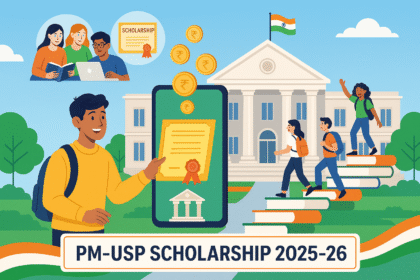I. Introduction: Unlocking Global Opportunities
A. The Mandate for Empowerment: A Government of India Initiative
The National Overseas Scholarship (NOS) for Students with Disabilities stands as a flagship Central Sector Scheme, meticulously administered by the Department of Empowerment of Persons with Disabilities (DEPwD), which operates under the aegis of the Ministry of Social Justice & Empowerment, Government of India. At its core, the scheme is an instrument of profound social and educational empowerment. Its primary mandate is to furnish comprehensive financial assistance to meritorious Indian students with benchmark disabilities, thereby creating a viable pathway for them to pursue advanced higher education—specifically Master’s level courses and Doctor of Philosophy (Ph.D.) programs—at esteemed and accredited foreign universities and institutions.
- I. Introduction: Unlocking Global Opportunities
- II. The Eligibility Gauntlet: A Definitive Checklist for Applicants
- III. The Financial Architecture: A Complete Breakdown of Support
- IV. The Application Dossier: A Step-by-Step Procedural Guide
- V. The Selection Labyrinth: From Screening to Final Award
- Scholarship Eligibility Tracker
- VI. The Awardee’s Compact: Post-Selection Obligations and Conditions
- VII. Concluding Analysis and Recommendations for Prospective Applicants
The philosophy underpinning this initiative extends beyond mere financial aid. It is a concerted effort to dismantle the multifaceted barriers—be they physical, financial, psychological, or systemic—that have historically impeded the academic and professional aspirations of persons with disabilities. The stated aim is to support these students “to prepare themselves to earn their livelihood and to find a dignified place for themselves in the society”. By facilitating access to world-class education, the Government of India seeks to foster a new generation of highly skilled professionals and leaders who can contribute meaningfully to the nation’s progress upon their return.
A critical examination of the scheme’s operational history reveals a persistent challenge. Official reports from the Press Information Bureau (PIB) have noted that, in past years, the scheme has experienced an “underutilization of available scholarship berths for consecutive years”. This was not due to a lack of interest but rather a significant number of applicants failing to meet the stringent eligibility criteria, particularly concerning age and minimum academic marks. This points toward a crucial information gap between the administrative body and the pool of potential applicants. Many deserving candidates may be making fundamental errors in their applications or are unaware of the exacting standards required. Therefore, this guide is designed not only to inform but to meticulously navigate every nuance of the scheme, serving as an essential tool to bridge this gap, prevent common application errors, and ultimately enhance the scheme’s utilization rate, ensuring that these transformative opportunities reach their intended recipients.
B. Scope and Structure of the Scholarship
The National Overseas Scholarship is precisely targeted at postgraduate and doctoral studies. It is imperative for applicants to understand that Bachelor’s level courses, regardless of the discipline, are explicitly excluded from the purview of this scheme. The government allocates a total of
20 awards annually under this program.
In alignment with the principles of gender equity and empowerment, the scheme incorporates a significant reservation policy. A substantial 30% of the total available slots, translating to 6 awards each year, are specifically earmarked for women candidates. The guidelines further stipulate that should an insufficient number of eligible female candidates apply or be selected in a given year, these unutilized slots can then be allocated to suitable male candidates, ensuring that the full quota of scholarships is awarded whenever possible.
The scholarship supports a broad yet specific spectrum of academic disciplines, categorized into five major fields of study. This structure allows for a diverse range of academic pursuits while aligning with national development priorities. The specified fields are:
- Engineering & Management
- Pure Sciences & Applied Sciences
- Agricultural Science & Medicine
- Commerce, Accounting & Finance
- Humanities, Social Science & Fine Arts (this category also includes Law).
This structured approach ensures that the investment in human capital is distributed across various sectors critical to India’s economic and social fabric.
II. The Eligibility Gauntlet: A Definitive Checklist for Applicants
Navigating the eligibility criteria is the most critical phase of the application process. A thorough understanding of and adherence to these requirements is non-negotiable for any prospective candidate. The criteria can be systematically broken down into foundational, academic, and socio-economic parameters.

A. Foundational Criteria: The Non-Negotiables
These are the absolute prerequisites that every applicant must meet without exception.
- Citizenship: The scholarship is exclusively available to individuals who are citizens of India.
- Disability Benchmark: The scheme is targeted at students with a significant level of disability. Applicants must have a “benchmark disability,” which is legally defined as a disability of not less than 40% as stipulated in the Rights of Persons with Disabilities Act, 2016.
- Mandatory Unique Disability Identity (UDID): A crucial administrative requirement is the possession of a valid Unique Disability Identity (UDID) card or, at the minimum, a UDID enrolment number. This is a mandatory condition for an application to be considered. The official application form underscores the centrality of this requirement by making the UDID number one of the very first pieces of information to be provided by the applicant.
B. Academic Prerequisites: Demonstrating Merit
Beyond the foundational criteria, applicants must demonstrate a consistent record of academic excellence. The minimum performance benchmarks are clearly defined.
- For Ph.D. Applicants: Candidates seeking the scholarship for a doctoral program must have secured a minimum of 55% marks or an equivalent grade in their relevant Master’s Degree from a recognized university or institution.
- For Master’s Degree Applicants: Similarly, those applying for a Master’s level course must have obtained a minimum of 55% marks or an equivalent grade in their relevant Bachelor’s Degree.
- Grade Conversion Protocol: The scheme acknowledges that many universities use a grading system such as the Cumulative Grade Point Average (CGPA), Overall Grade Point Average (OGPA), or Semester Grade Point Average (SGPA). In such cases, it is the applicant’s responsibility to provide an official, certified document from their university that clearly explains the formula for converting these grades into a percentage. This document must be submitted along with the academic transcripts.
- Preference for Experience: The scheme guidelines include a clause that gives preference to certain candidates. Specifically, “preference would be given to the experienced candidates, especially to those who are on lien with their existing post and employer”. This suggests that applicants who have some work experience in their field of study, particularly those who are officially on leave from a current job to pursue higher education, may have an advantage during the selection process.
C. Age and Income Ceilings: The Socio-Economic Filters
The scholarship is designed to support younger scholars from economically constrained backgrounds. Therefore, strict age and income limits are enforced.
- Age Limit: Applicants must be below 35 years of age. There is a slight variation in the official documentation regarding the precise cut-off date. Some older guidelines mention it as “the first day of the month of the advertisement of the scheme” , while more recent documents and parliamentary replies specify “as on 1st January of the year of application”. Applicants should refer to the latest guidelines published by the DEPwD for the specific application year to ensure compliance.
- Annual Family Income Ceiling: The total annual income of the applicant’s family (parents/guardians) from all sources must not exceed a specified ceiling. It is vital for applicants to be aware of the most current income limit, as this has been subject to revision. While older scheme documents from the 2014-15 period and some informational websites cite a ceiling of ₹6,00,000/- per annum , this information is outdated. More recent and authoritative sources, including a formal reply in the Rajya Sabha in 2023 and the latest scheme guidelines, have confirmed that the revised and currently effective annual family income ceiling for the National Overseas Scholarship for Students with Disabilities is ₹8,00,000/- (Rupees Eight Lakh). This upward revision is a significant policy update, likely intended to account for inflation and widen the pool of eligible candidates. Relying on the old ₹6 lakh figure could lead to deserving candidates incorrectly self-disqualifying. Therefore, applicants whose family income is up to ₹8 lakh per annum are encouraged to apply.
D. Key Exclusions and Limitations: Rules to Heed
To ensure the equitable distribution of this limited and prestigious award, several exclusionary rules are in place.
- One-Time Award: The scholarship is a once-in-a-lifetime opportunity. An individual who has previously received this award cannot be considered for it a second time.
- Family Limit: The benefits of the scheme are restricted to a maximum of two children with disabilities from the same parents or guardians. To this effect, the applicant is required to provide a self-certification. The guidelines provide a compassionate exception in the case of twins; if the second eligible child is a twin, the scholarship is admissible to both.
- Prohibition on Concurrent Scholarships: An awardee of the National Overseas Scholarship is not permitted to hold any other scholarship or receive a stipend from any other source simultaneously. If a selected candidate is offered another scholarship, they must make a choice. They are required to select the award that is more beneficial to them and formally inform the awarding authority of their decision.
- Ineligibility for Candidates Already Abroad: The scheme is intended to facilitate new opportunities for overseas education, not to retroactively fund ongoing studies. Therefore, candidates who are already staying abroad, are currently enrolled in a foreign university, or have already completed their studies abroad using any other scholarship or through self-funding are not eligible to apply.
III. The Financial Architecture: A Complete Breakdown of Support
The financial assistance provided under the National Overseas Scholarship is comprehensive, designed to cover nearly all major expenses associated with studying and living abroad. The support structure is detailed and specific, with certain allowances varying based on the country of study.

A. Core Financial Allowances
These allowances form the bulk of the financial support and cover tuition and living expenses.
- Tuition Fees: The scholarship provides for the full payment of actual tuition fees as levied by the foreign university or institution. This is a significant benefit, as international student fees can be prohibitively expensive.
- Annual Maintenance Allowance: This is a stipend to cover the cost of living, including accommodation, food, and other personal expenses. The amount is standardized based on the relative cost of living in different regions:
- For students studying in the United States of America (USA) and all other countries except the United Kingdom: The allowance is $15,400 (US Dollars) per annum.
- For students studying in the United Kingdom (UK): The allowance is £9,900 (Great Britain Pounds) per annum.
- Annual Contingency Allowance: This allowance is provided to cover academic expenses beyond tuition, such as the purchase of books, essential apparatus, costs associated with study tours, travel for attending subject-related conferences or workshops, and expenses for typing and binding of the thesis. The amounts are:
- For the USA and other countries (except UK): $1,500 (US Dollars) per annum.
- For the United Kingdom (UK): £1,100 (Great Britain Pounds) per annum.
B. Ancillary Support and Reimbursements
In addition to the core allowances, the scheme covers several other critical one-time and ongoing costs.
- Air Passage: The scholarship covers the cost of travel to and from the country of study. An economy class air ticket for the shortest available route from the nearest airport in India to the university and a return ticket upon completion of the course are provided. The cost of the onward journey is typically reimbursed to the student after their arrival abroad, while the return ticket is arranged by the concerned Indian Mission.
- Visa Fees: The actual fees incurred for obtaining the student visa are reimbursed to the awardee in Indian Rupees.
- Medical Insurance Premium: The cost of a medical insurance policy for the duration of the course is also admissible and will be paid as per the actual premium charged.
- One-Time Allowances: To cover initial settling-in costs, two small one-time allowances are provided:
- Incidental Journey Allowance: A payment of $20 (US Dollars) or its equivalent in Indian Rupees.
- Equipment Allowance: A payment of $20 (US Dollars) or its equivalent. Some documents also mention an equipment allowance of 1500 INR, so applicants should verify the prevailing rate at the time of their award.
C. Duration and Disbursement Mechanism
The financial support is provided for a fixed maximum duration, and the funds are channeled through a specific official mechanism.
- Maximum Duration of Award: The scholarship is tenable for the entire duration of the course, up to a specified maximum period:
- For Ph.D. programs: Financial assistance is provided for a maximum of four years.
- For Master’s Degree programs: Assistance is provided for a maximum of three years, contingent on the actual duration of the course.
- Disbursement Process: It is crucial to note that the scholarship funds are not transferred directly into the student’s personal bank account in India. Instead, the Ministry allocates the funds to the respective Indian Missions (i.e., the Embassy or High Commission of India) in the country where the student is studying. The Indian Mission then manages the disbursement, making direct payments to the university for tuition fees and releasing the maintenance and other allowances to the student periodically. This centralized process ensures accountability and timely payment.
Table 1: Financial Benefits at a Glance
| Type of Assistance | Amount (USA & Other Countries) | Amount (UK) | Frequency / Remarks |
|---|---|---|---|
| Tuition Fees | Actuals as charged | Actuals as charged | Paid directly to the university |
| Maintenance Allowance | $15,400 | £9,900 | Per Annum |
| Contingency Allowance | $1,500 | £1,100 | Per Annum |
| Air Passage | Economy Class Fare (Actuals) | Economy Class Fare (Actuals) | Return trip covered |
| Visa Fees | Actuals in INR | Actuals in INR | One-time reimbursement |
| Medical Insurance Premium | Actuals as charged | Actuals as charged | For the duration of the course |
| Incidental Journey Allowance | $20 | $20 (or equivalent) | One-time payment |
| Equipment Allowance | $20 | $20 (or equivalent) | One-time payment |
IV. The Application Dossier: A Step-by-Step Procedural Guide
The application process for the National Overseas Scholarship for Students with Disabilities is distinct from many other government schemes. It requires careful preparation of a physical dossier of documents and adherence to a specific submission protocol.
A. The Offline Application Process
A key feature of this scheme is that its implementation is offline. While many scholarships have transitioned to the online National Scholarship Portal (NSP), applicants for this particular award must submit a hard copy of their application. Another unique aspect is that applications are officially.

accepted throughout the year, allowing candidates to apply as soon as they meet the criteria, particularly after securing a university admission offer.
The process can be broken down into the following steps:
- Step 1: Download the Application Form: The official application form must be downloaded from the website of the Department of Empowerment of Persons with Disabilities. The correct web address is typically www.depwd.gov.in (a link may also be available at disabilityaffairs.gov.in).
- Step 2: Complete the Form: The form must be filled out meticulously and legibly, using block letters only, in either English or Hindi. Every section of the form must be completed, as incomplete applications are liable to be rejected.
- Step 3: Compile Required Documents: Gather all the mandatory documents as specified in the application form and scheme guidelines. A comprehensive checklist is provided in the next section. All photocopies should be self-attested where required.
- Step 4: Submit the Application: The completed application form, along with all the required enclosures, must be sent by post to the designated address in New Delhi. The correct mailing address is:Under Secretary (Scholarships) Department of Empowerment of Persons with Disabilities Room No. 516, 5th Floor, Pt. Deendayal Antyodaya Bhawan CGO Complex, Lodhi Road New Delhi – 110 003.
B. Compiling the Mandatory Documentation: A Comprehensive Checklist
The completeness and correctness of the submitted documents are paramount. A single missing or improperly formatted document can lead to the rejection of the application. The following checklist, compiled from the official application form and scheme guidelines, should be followed rigorously.
The strategic importance of one document cannot be overstated: the Offer of Admission Letter. The application form itself contains the explicit statement: “If you don’t have any offer letter, you are not eligible to apply under NOS Scheme”. This fundamentally shapes the entire application timeline. Unlike schemes where a student applies for funding first, for the NOS, the candidate must first independently secure admission to a foreign university. The scholarship application is therefore the final step in making that admission financially viable. This means prospective applicants must prioritize their university applications months, or even a year, in advance. The scholarship does not facilitate admission; it facilitates the affordability of an admission already earned on the applicant’s own merit.
Table 2: Mandatory Document Checklist
| Document Category | Specific Document | Key Requirements / Notes |
|---|---|---|
| Personal | Recent Passport-size Photograph | Must be pasted in the designated space on the application form. |
| Personal | Proof of Date of Birth | Self-attested copy of either the Class 10th Board Certificate or the official Birth Certificate. |
| Personal | Disability Certificate / UDID Card | Self-attested copy is mandatory. Must clearly state the type and percentage of disability (≥40%). |
| Personal | Aadhaar Card | Self-attested copy is mandatory. Serves as primary proof of identity. |
| Personal | Proof of Residence | Required only if the correspondence address is different from the address on the Aadhaar Card. |
| Personal | Passport | Self-attested copy of the first and last pages. To be submitted if available at the time of application. |
| Academic | Academic Transcripts | Self-attested copies of all certificates, mark sheets, and transcripts for every examination from the Bachelor’s degree onwards. |
| Academic | Grade-to-Percentage Conversion | An official certificate from the university/institution explaining the formula, if marks are awarded in grades (CGPA/SGPA/OGPA). |
| Financial | Annual Income Certificate | Must be issued by a Revenue Officer not below the rank of Tehsildar. For employed parents/guardians, a consolidated certificate covering all sources of income is required. |
| Admission | Offer of Admission Letter | A copy of the unconditional (or conditional, with clear conditions) offer letter from the accredited foreign university. This is a non-negotiable prerequisite. |
| Admission | Details of Proposed Study | A statement or essay (up to 500 words) detailing the proposed course of study, its relevance, and research topic (if applicable). |
| Declarations & Other | Self-Declaration (Other Scholarships) | A signed statement confirming that the applicant is not availing any other scholarship for the same course. |
| Declarations & Other | Self-Declaration (Family Limit) | A signed statement confirming adherence to the “not more than two children” rule. |
| Declarations & Other | No Objection Certificate (NOC) | Required from the current employer if the applicant is employed. |
V. The Selection Labyrinth: From Screening to Final Award
The selection process for the National Overseas Scholarship is a rigorous, multi-stage procedure designed to identify the most meritorious and suitable candidates from the pool of applicants. It ensures that the awards are granted based on a comprehensive assessment of academic achievement, personal circumstances, and the quality of the proposed plan of study.
A. The Two-Tier Evaluation Process
The evaluation of applications is conducted by two distinct committees, each with a specific role in the selection pipeline.
- Stage 1: The Screening Committee: All applications received by the Department are first placed before a Screening Committee. The primary function of this committee is to perform the initial vetting. It scrutinizes each application for completeness and verifies whether the applicant meets all the basic eligibility criteria as laid down in the scheme guidelines. Applications that are incomplete, lack mandatory documents, or belong to candidates who do not meet the fundamental requirements (such as age, income, disability percentage, or academic marks) are filtered out at this stage.
- Stage 2: The Selection Committee: The applications that are successfully shortlisted by the Screening Committee are then forwarded for the final consideration of the Selection Committee. This is the high-level body responsible for making the final decision on who will be awarded the scholarship. While some older guidelines for the scheme mentioned the possibility of a personal interview with the shortlisted candidates , more recent procedural descriptions tend to emphasize a final assessment based on the detailed application dossier submitted by the candidate. The Selection Committee’s decision is final and completes the selection procedure.
B. Criteria for Merit and Final Selection
The Selection Committee conducts a holistic and merit-based assessment of each shortlisted candidate. The final merit list is prepared based on a careful evaluation of several key factors that collectively paint a picture of the applicant’s potential for success. The primary criteria for assessment include:
Scholarship Eligibility Tracker
Enter your details on the left to get an instant assessment.
This tracker provides a preliminary assessment. Always refer to the official DEPwD guidelines for definitive eligibility and terms.
- Educational Qualifications: A detailed review of the candidate’s academic record, including the percentage of marks obtained, the reputation of their previous institutions, and any academic honors or distinctions received.
- Disability Category and Percentage: The nature and extent of the candidate’s disability are considered as part of the overall profile assessment.
- Standing of the Foreign University: The prestige and ranking of the foreign university from which the applicant has secured an admission offer is a heavily weighted criterion. The committee often refers to the latest available QS World University Rankings to gauge the quality of the institution. Securing admission to a highly-ranked university significantly strengthens an application.
- Proposed Course of Study: The relevance, academic rigor, and potential impact of the proposed Master’s or Ph.D. program are carefully evaluated.
It is a strict condition of the award that once a candidate is selected for a specific course at a specific university, no subsequent changes to either the course or the institution are permitted.
VI. The Awardee’s Compact: Post-Selection Obligations and Conditions
Receiving the National Overseas Scholarship is not merely the acceptance of a grant; it is the entrance into a formal agreement with the Government of India. This compact comes with a set of significant legal, financial, and ethical obligations that every awardee must fulfill. These conditions are designed to ensure accountability and to align the individual’s opportunity with the larger national interest.
A. Executing the Bond and Legal Formalities
Upon receiving the final confirmation or award letter, the selected candidate must complete a series of critical legal formalities. There is a strict timeline for this: all procedures, including the verification of original documents and the submission of legal bonds, must be completed within six months from the date of issuance of the confirmation letter. Failure to meet this deadline will result in the automatic cancellation of the scholarship award.
The central legal instrument is the Surety Bond. The awardee is required to execute a bond on a non-judicial stamp paper, which must be notarized. This bond is a legal undertaking and must be supported by two sureties. The value of the bond is set at the actual amount that the government estimates it will spend on the candidate’s education abroad, or a minimum of Rs. 50,000, whichever amount is greater. Each of the two sureties must execute a separate bond and must also provide a
solvency certificate to prove their financial capacity to back the bond. This is a substantial legal and financial commitment, designed to act as a guarantee that the candidate will adhere to all the terms and conditions of the scholarship, particularly the requirement to return to India.
B. The Return to India Mandate
Perhaps the most significant post-award obligation is the mandatory requirement for the awardee to return to India. The scheme guidelines are unequivocal on this point: awardees must return to India within one month following the completion of their approved course of study. The scheme explicitly states that no financial support, under any circumstances, will be provided for any period of extended stay abroad beyond the course duration. To ensure compliance, candidates are advised to apply for a student visa type that necessitates their return to India upon the conclusion of their academic program.

This mandate is not merely an administrative rule; it is the philosophical cornerstone of the scholarship. The government’s substantial investment in each scholar is made with the explicit expectation of a “return on investment” in the form of human capital. The program is structured as a “brain gain” initiative, designed to prevent the permanent migration of India’s brightest minds. By requiring scholars to return, the scheme ensures that the advanced skills, global perspectives, and specialized knowledge they acquire are brought back to contribute to India’s development, research, and innovation landscape. Applicants must therefore understand that they are not just receiving a personal grant, but are entering into a compact to serve as a national resource upon their return.
C. In-Country Monitoring and Academic Progress
The oversight of the awardee does not end once they depart for their studies. The Indian Mission (the Embassy or High Commission of India) in the host country plays a vital ongoing role. The Mission is responsible for the periodic disbursement of maintenance and other allowances and also serves as the primary body for monitoring the awardee’s academic progress.
Awardees are required to register with the Indian Mission immediately upon their arrival in the foreign country. They must also arrange for their university to submit periodic progress reports to the Mission. The continuation of financial support throughout the duration of the scholarship is contingent upon the awardee maintaining satisfactory academic standing.
The scheme has stringent penalties for non-compliance. In the event that a student provides false information at any stage, fails to complete the course without a valid reason, or violates any of the mandatory conditions of the award (such as the return-to-India mandate), they will be considered in default. A defaulter is legally obligated to repay the entire amount of the scholarship expended by the government, with a specified rate of interest.
VII. Concluding Analysis and Recommendations for Prospective Applicants
The National Overseas Scholarship for Students with Disabilities is a truly transformative opportunity, offering a fully-funded pathway to the world’s leading academic institutions. However, securing this prestigious award requires more than just academic merit; it demands strategic planning, meticulous preparation, and a clear understanding of the scheme’s underlying principles and stringent requirements.
A. Strategic Considerations for a Successful Application
Based on a comprehensive analysis of the scheme’s structure and common pitfalls, prospective applicants should adopt the following strategic approach:
- Prioritize University Admission Above All: The single most important realization for any applicant is that the scholarship application follows, and is entirely dependent on, securing an admission offer. The process of researching universities, preparing for standardized tests (like GRE, GMAT, TOEFL), and completing university applications is a long and arduous one. Therefore, this process should begin at least 12 to 18 months before the intended academic start date. The scholarship application is the final piece of the puzzle, not the first.
- Target High-Ranking Institutions: The selection committee gives significant weight to the QS World University Ranking of the institution providing the admission offer. Applicants should strategically target universities that are well-ranked in their chosen field of study, as this will substantially increase the competitiveness of their scholarship application.
- Achieve Documentation Perfection: The offline application process leaves no room for error. The primary reason for the historical underutilization of this scheme has been the failure of applicants to meet eligibility criteria, which often manifests as incomplete or incorrect documentation. Applicants must use a detailed checklist, such as the one provided in this guide, to ensure every required document is present, correctly formatted, and properly attested. Special attention must be paid to securing the Annual Income Certificate from the correct authority (a Revenue Officer of Tehsildar rank or above) and ensuring it reflects the current income ceiling of ₹8 lakh per annum.
- Understand and Embrace the Compact: Applicants must view this scholarship not as a simple grant, but as a national investment and a solemn compact. They must be fully prepared to execute the legally binding surety bond and, most importantly, to honor the mandatory return-to-India condition. This understanding should be reflected in their application and their long-term career planning.
B. The Long-Term Vision: Fostering a Cadre of Global Leaders
Ultimately, the National Overseas Scholarship for Students with Disabilities is a visionary instrument of social justice and nation-building. By removing financial barriers to global education, the scheme empowers a segment of the population that has often faced systemic disadvantages. It creates a pipeline of highly qualified professionals, researchers, and academics with disabilities who are equipped with world-class knowledge and international exposure.
The return of these scholars to India is the final and most crucial phase of the scheme’s lifecycle. They are poised to become leaders in their respective fields, driving innovation, shaping policy, and serving as powerful role models for future generations. By investing in their potential, the Government of India is not only championing the rights and capabilities of persons with disabilities but is also strategically enhancing its own intellectual capital, ensuring that the fruits of global knowledge contribute directly to India’s growth, prosperity, and inclusive development.
The information in the articles and applications was compiled from official sources from the Government of India.
The primary source is the Department of Empowerment of Persons with Disabilities (DEPwD), which operates under the Ministry of Social Justice & Empowerment.
Specifically, the details were gathered from:
- The official scheme guidelines and application forms published by the DEPwD.
- Press releases and official communications from the Press Information Bureau (PIB).
- Documents and written replies provided in the Parliament of India (Rajya Sabha).
These materials are generally made available through the official websites, such as depwd.gov.in and the National Scholarship Portal.








